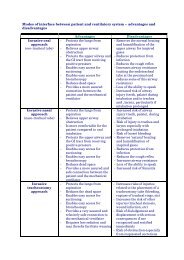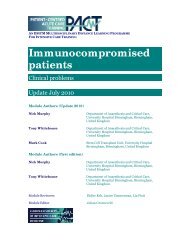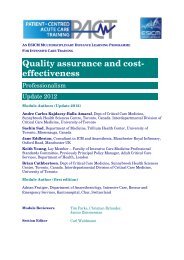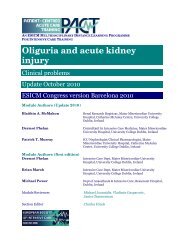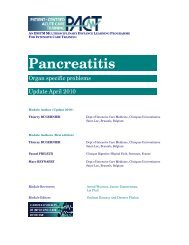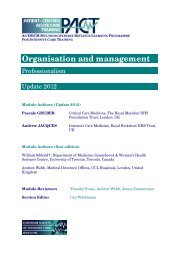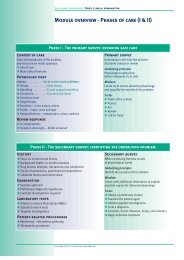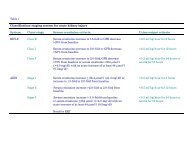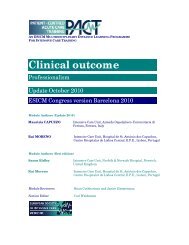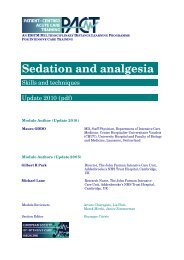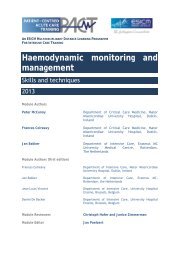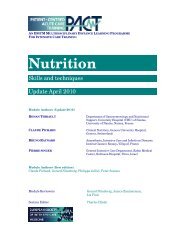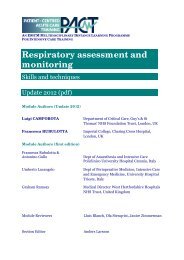Burns injury - PACT - ESICM
Burns injury - PACT - ESICM
Burns injury - PACT - ESICM
Create successful ePaper yourself
Turn your PDF publications into a flip-book with our unique Google optimized e-Paper software.
3/ ONGOING FLUID AND SURGICAL MANAGEMENT<br />
Fluids (24–72 hrs)<br />
After primary fluid resuscitation (0–24 hrs), the patients have oedema and are loaded<br />
with salt. At this stage, standard crystalloid solutions are replaced by hypotonic<br />
solutions (glucosaline, dextrose 5% or N/2 saline) and colloids are added (0.5 mL x<br />
BW (kg) x %TBSA Burned= mL colloid/24 hrs) while aiming for 0.5 mL/kg/hr of urine<br />
output (1 mL/kg/hr in children). After 48 hrs, the goal is a negative salt and fluid<br />
balance and an intravascular volume that is adequate. The ambition is to bring the<br />
patient back to his/her usual weight within 7-10 days after the <strong>injury</strong>.<br />
Hypernatraemia is frequently observed during this fluid reversal phase and the use of<br />
thiazide diuretics may be considered. Due to evaporation it is important to give<br />
enough water e.g. as intravenous glucose 5% (glucose 50 mg/mL in water or as<br />
enteral water, usually via an NG tube). Other electrolyte disorders such as low<br />
potassium, phosphate and magnesium are common. The complication of most<br />
concern however is fluid overload due to ‘fluid creep’ – see below.<br />
Pruitt BA Jr. Protection from excessive resuscitation: ‘pushing the pendulum<br />
back’. J Trauma 2000; 49(3): 567–568. PMID 11003341<br />
Holm C, Melcer B, Hörbrand F, Wörl H, von Donnersmarck GH, Mühlbauer W.<br />
Intrathoracic blood volume as an end point in resuscitation of the<br />
severely burned: an observational study of 24 patients. J Trauma 2000;<br />
48(4): 728–734. PMID 10780609<br />
Bacomo FK, Chung KK. (2011) A primer on burn resuscitation. J Emerg Trauma<br />
Shock 2011; 4(1): 109–113. PMID 21633578<br />
Greenhalgh DG. Burn resuscitation: the results of the ISBI/ABA survey. <strong>Burns</strong><br />
2010; 36(2): 176–182. PMID 20018451<br />
Lund T, Wiig H, Reed RK. Acute postburn edema: role of strongly negative<br />
interstitial fluid pressure. Am J Physiol 1988; 255(5 Pt 2): H1069–1074.<br />
PMID 3189570<br />
Baxter CR, Shires T. Physiological response to crystalloid resuscitation of severe<br />
burns. Ann N Y Acad Sci 1968; 150(3): 874–894. PMID 4973463<br />
Surgical procedures 0–24 hrs and beyond<br />
Excision of the burn wound<br />
Assessment of burn depth is often difficult and it may delay surgery as spontaneous<br />
healing is preferable in all cases where the healing is finalised before day 10-14 post<br />
burn. In cases of clear full-thickness burns, early excision is the state of the art<br />
recommendation.<br />
14



